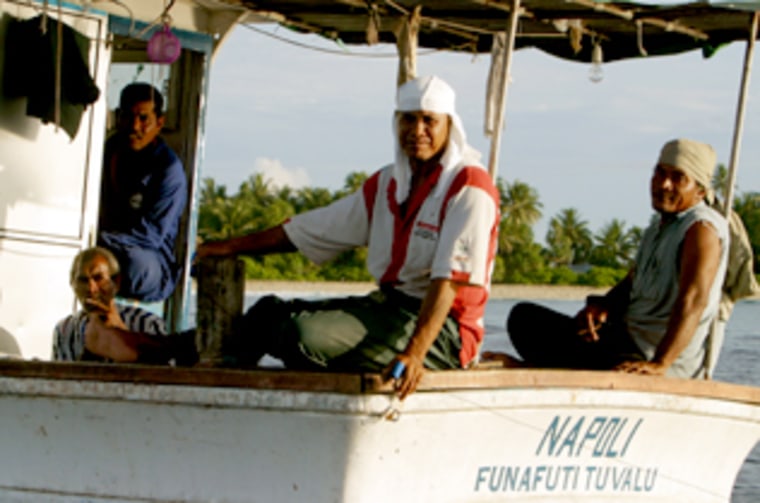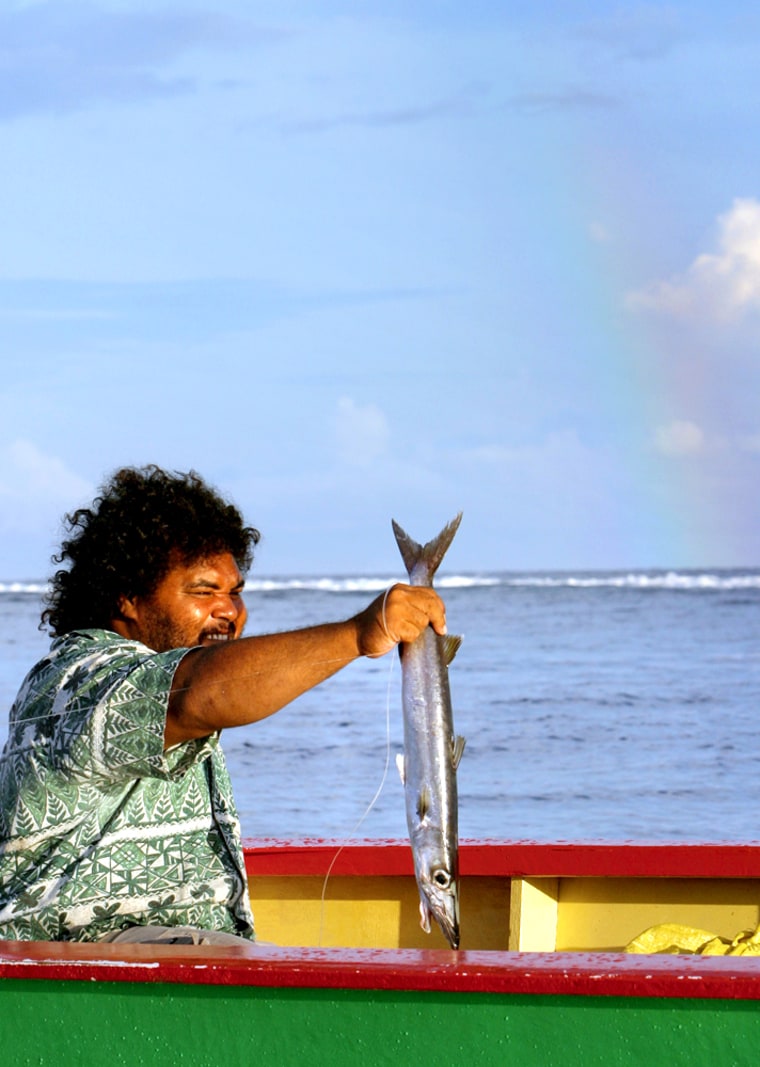Rocking in the ocean swells, the fishermen held up empty hands when their rusting tub of a tuna boat was hailed from a passing skiff.
“No, it’s bad! The fishing is bad!” Tanemuga Tenae shouted across from his stern. “Too many boats! Too many Japanese boats!”
Closer inshore, another islander lifted a silvery skipjack from the well of his one-man outboard — a single tuna for a morning’s work.
“There’s a lot less fish than when I started 15 years ago,” a third fisherman, Soloseni Penitusi, told a visiting reporter later this steamy day on Funafuti atoll, a strip of sand and poverty in the remote mid-Pacific.
Penitusi was peddling small skipjack from the back of a pickup truck — discards from a big American boat that had swept up hundreds of tons of better tuna.
“It’s because there are a lot more foreign boats,” he said. Then should the Tuvalu government sell fewer licenses to foreign fleets? he was asked.
“No,” he said, smiling at the dilemma. “I can’t say that. We need that money.”
Pacific islands get treaty
That money is needed, and that dilemma is felt, on scores of islands across the Pacific, the vast setting for what may become one of the great battles between consumption and conservation in the 21st century, as a growing appetite for fish meets oceans fast being emptied of them.
For islanders like Danny Wase, fisheries director for another Pacific nation, the Marshall Islands, his people’s future hinges on the outcome.

“The fisheries are the only resource we have for our economic independence,” Wase said on Majuro atoll, 1,250 miles north of here. “It’s really important we sustain that long term.”
Island nations took a step toward sustaining it last month, when a new treaty took effect to regulate tuna fishing in the western and central Pacific, the last major ocean area without a regime — however flawed — for managing fish stocks.
The United States, Japan and other fishing powers have yet to accept that Pacific pact, however. Needy island governments, meanwhile, are opening their waters to still more big appetites — the Spanish, French and other European fishing nations, whose formidable tuna fleets have already depleted stocks in the Atlantic and have moved into the Indian Ocean.
Under new licensing deals, European Union vessels are soon expected to join more than 1,000 Asian and American boats fishing in the Pacific islands’ 200-mile-wide economic zones — the millions of square miles of sea that surround scattered bits of land.
The boats roaming the Pacific are both long-liners, which catch prized, deep-running tuna by trailing lines with thousands of baited hooks, and purse-seiners, whose mammoth nets close in on huge schools near the surface, mostly skipjack, the common canned tuna.
The boats’ quarry — fish of the genus “Thunnus” — are streamlined, speedy, meaty nomads of the sea that migrate over vast ocean distances and that for centuries have been one of man’s most important food fishes.
Fleet increased 50 percent
The Pacific was one of the world’s last healthy fisheries, supplying two-thirds of the global tuna catch of 4 million tons a year. But even Pacific tuna now look increasingly in trouble.
Like oil on land, hidden reserves of tuna deep in the seas are difficult to assess. But scientists concluded last year that bigeye tuna, a favorite of Japan’s sashimi market, was being overexploited in the Pacific. Yellowfin tuna, another large, valuable variety, may be just as threatened, they say. Expanding the fishing effort could wipe them out.
“Islanders early on thought of how to make the most money,” Gary Sakagawa, a senior scientist with the U.S. National Marine Fisheries Service, said in an interview in San Diego. “I think they feel they have overdone it.”
“Within three to five years, some stocks could be critically overfished,” the environmental group Greenpeace concluded in a report on Pacific tuna last February.
The trouble began in the 1980s, when the tuna catch doubled as the new, highly efficient purse-seiners began cruising into the central and western Pacific from the American coast and east Asia. More recently, it was the expansion of the fleets — from 827 boats registered in 1997-98 to 1,233 in 2001-2002 — that put more pressure on fish stocks.
Fees only a small cut
The islands made money along the way, though not much. In recent years, 15 island governments, from Palau in the west to Kiribati in the east, have together received between $60 million and $80 million in annual access fees, a tiny fraction of the roughly $2 billion value of the yearly catch.
Here in Tuvalu, whose 9,000 people are spread over far-flung atolls midway between Hawaii and Australia, the fishing fees usually finance about 20 percent of the national budget. But that’s “peanuts,” complained Amasone Kilei, a member of the mini-nation’s Parliament.
“It’s less than a cent a kilogram,” he said. “Countries overseas are getting a lot out of our oceans, and we’re not negotiating hard enough for ourselves.”
Island nations belong to a single multilateral agreement covering the U.S. tuna fleet, but otherwise each small government bargains one-on-one with such powers as Japan and South Korea. In those bilateral dealings especially, islanders feel shortchanged, or fall to temptation.
Last month, the Fiji government suspended its fisheries director, alleging he took bribes from Chinese companies to issue fishing licenses. His department had sought to issue four times more permits for Fijian waters than recommended by consultants. He denied wrongdoing.
Few on-board inspections
Official corruption has long undermined conservation efforts in the impoverished Pacific, environmentalists say. But simple “pirate” fishing may be doing even more, both by unlicensed vessels poaching in the 200-mile economic zones, and by licensed boats that underreport their catch, to save on fees paid by tonnage.

“We can’t solve that problem because we don’t have anyone on board. They might report 10 tons caught when it’s 100 tons,” said Sautia Maloufenua, Tuvalu’s fisheries director.
No one knows, but total catch may be underreported by 50 or 100 percent, Maloufenua said in his ramshackle upstairs office beside Funafuti’s breezy lagoon beach.
Sakagawa and others dispute such high estimates of illicit catch, but the Food and Agriculture Organization (FAO), the U.N. agency monitoring fisheries, says in some areas around the world it has reports of four times as much illegal as legal fishing.
To combat illegals, island governments deploy a patchwork of surveillance: on-board observers on U.S. boats under the multilateral agreement; an electronic Vessel Monitoring System that tracks almost all licensed boats via satellite; their own patrol boats, and occasional reconnaissance flights by Australian, New Zealand, French and U.S. planes.
The patchwork has gaping holes, however: Most boats fish without observers on board; satellites can’t weigh the fish in the holds; and many island governments, with huge swaths of ocean to cover, have only one patrol boat.
Treaty still needs tweaking
When the new Pacific tuna treaty took effect on June 19, the fishing powers and island nations were given a fresh chance to agree on how to protect tuna stocks, in a world where the FAO now reports 75 percent of fisheries are fully exploited, overexploited or depleted.
The treaty envisions controls on fishing on the high seas — the relatively small “doughnut holes” of ocean that fall outside and between the islands’ EEZs — exclusive economic zones. And it calls for high-seas regulations to coincide with regulations inside the EEZs, theoretically creating a seamless blanket of controls over the entire central and western Pacific.
“I think everybody is coming to accept the need for this,” said the Marshall Islands’ Wase. “But the mechanisms are still being worked out.”
Specialists suggest the best way to limit the tuna catch is to reduce the number of tuna boats in the region. The treaty’s new Pacific tuna commission will take up such discussions this December.
Key fishing nations may not be there, however. The treaty came into force after 12 island states, Australia and New Zealand ratified it, but the United States, Japan, China and South Korea have yet to commit.
“We’re expecting some to come to the party so they can be part of the upcoming commission when it meets,” said Ben Hall, spokesman for the South Pacific Forum Fisheries Agency, which represents island governments.
“But it’s all up in the air,” he said, and “there’s every possibility the fishing nations will try to water things down” when the commission takes up the complex arithmetic of tuna fishing.
The negotiations are expected to take years. Meantime, the Spaniards and others are closing in. Kiribati signed the first Pacific tuna-fishing deal with the Europeans in 2002. Others are lining up.
“We’re at the point of inviting discussions with the European Union,” said Tuvalu’s Maloufenua.
Also just over the horizon: Taiwanese “super super” seiners said to be able to handle up to 20,000 tons of fish a year, four times the amount big purse seiners now catch. Unseen beneath the waves, what’s left of Pacific tuna stocks await.
